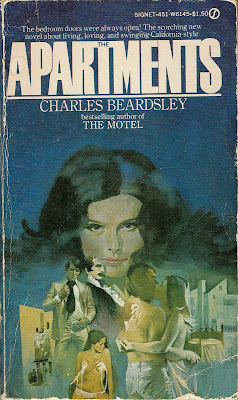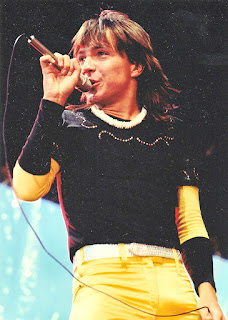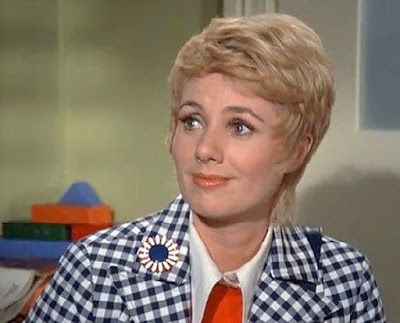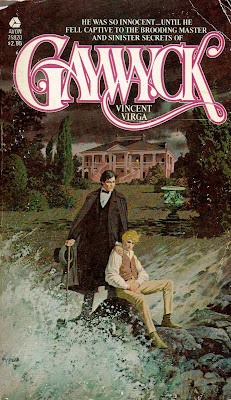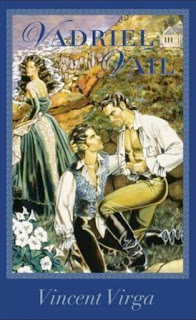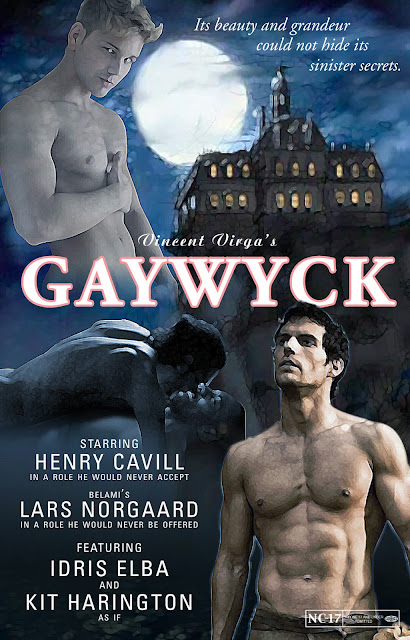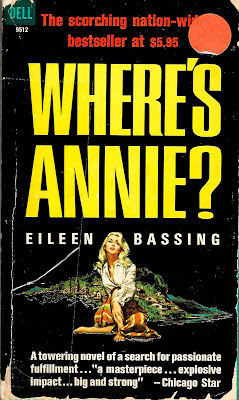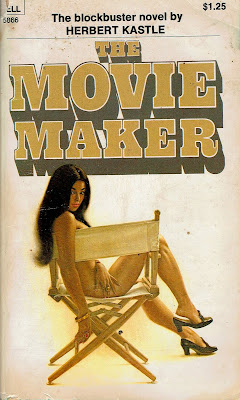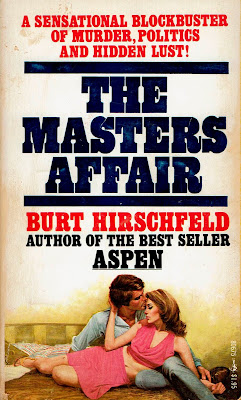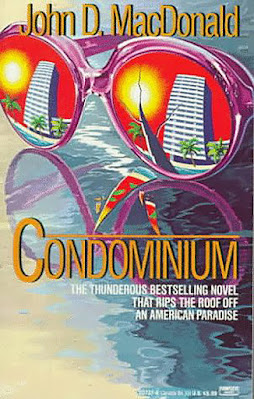 |
| The cover to Condominium’s 1978 paperback edition. Nice illustration, blah typography. |
Though Florida wasn’t without its weirdness when novelist and Sarasota resident John D. MacDonald was alive (he died in 1986), the state’s tinfoil hat-wearing population hadn’t yet grown into the national punchline/desired voting bloc that now provides fodder for the works of Barry, Carl Hiaasen and Tim Dorsey. Not that MacDonald would write novels like Bad Monkey or Florida Roadkill had he been confronted with today’s Florida Man; though not without humor, “wacky” is not an adjective I’d ascribe to MacDonald’s writing. MacDonald’s Florida is more grounded, at once seductive and sinister. You’ll come for the sunshine (and likely a woman and a large sum of money), but you might not survive your stay.
In MacDonald’s 1977 novel CONDOMINIUM, Florida’s Fiddler Key, the fictional stand-in for Siesta Key, where the author lived, is a haven for retirees, drawn to the beautiful beaches, the warm weather and the affordable luxury of the Golden Sands condominium. They’re easy marks for real estate developer Marty Liss, who built many of the condos on Fiddler Key, Golden Sands among them, and has plans to build another one — Harbour Pointe — next to it, confident his luck will prevail despite a flagging real estate market. Liss, who “had a third wife he mistrusted and two grown children he despised,” gets his confidence bolstered by his secretary Drusilla, with whom he shares trysts between business meetings. Life is good in Fiddler Key, and it can only get better.
Of course, we know it can’t. Residents at Golden Sands begin to suspect they were sold a bill of goods. Many of them are up in arms about maintenance fees being doubled, especially when they’re already made responsible for any repairs needed in their units (Julian Higbee, who manages the Golden Sands with his wife Lorrie, is more interested in bedding the younger female residents than wasting time fixing a geezer’s air-conditioner). This actually sets the stage for a vividly drawn condo residents’ meeting, the tedium, the tangents, the tantrums and, ultimately, the futility immediately recognizable to anyone who has attended a meeting where the floor is opened for attendees to speak.
Retired engineer Gus Garver is a resident who has concerns about Golden Sands’ very structure. Gus only bought his unit because his wife Carolyn fell in love with the place, but the couple were barely in it a year before Carolyn suffered a series of medical emergencies, beginning, I shit you not, with a slip on a discarded banana peel, and wound up in a nursing home. Without his wife around to sing Golden Sands’ praises — and without a job to occupy his time — Gus begins to take note of the condo’s flawed construction. The building wouldn’t stand up in earthquake country, he observes. What are its chances in hurricane country?
Meanwhile, Liss runs into a snag with his proposed Harbour Pointe project when his bank puts a freeze on his line of credit. “The fat rosy ass has fallen off the economy,” the president of the bank explains. In an effort to keep in the developer’s good graces, the bank president puts Liss in touch with Sherman Grome, the shady-as-fuck CEO of an Atlanta-based real estate investment trust. Liss doesn’t like Grome or his questionable deal — a kickback scheme that requires Liss to take over Tropic Towers, a failing property Grome financed — but agrees so he can get Harbour Pointe built. And this is just the beginning of his problems.
Because Liss has greased a lot of palms in city and county government, construction on Harbour Pointe begins almost as soon as Liss deposits Grome’s check. To the horror of the denizens of Golden Sands, the lush tropical jungle beside their building is bulldozed to make way for the new condo. Liss, of course, doesn’t lose much sleep over the cries of his properties’ outraged residents. He doesn’t even worry too much about the FBI looking into Sherman Grome’s business deals — that is, until Liss’s associates start cooperating with investigators.
While Marty Liss’s business crumbles and Golden Sands residents’ dreams shatter, few people are thinking about hurricanes. Garver is like a dog with a bone, however, and with the financial help of Golden Sands’ very rich and very ill penthouse resident LeGrande Messenger (think Warren Buffet with cancer), commissions a colleague, marine civil engineer Sam Harrison, to make a thorough investigation to determine Golden Sands’ chances of withstanding natural catastrophe. Sam is just as dogged as Gus, though he soon becomes preoccupied by feelings for Messenger’s much younger and very attractive wife, Barbara.
And out in the Atlantic, tropical storm Ella is gaining strength as she heads toward the Gulf Coast...
More Than Corruption and Natural Disaster
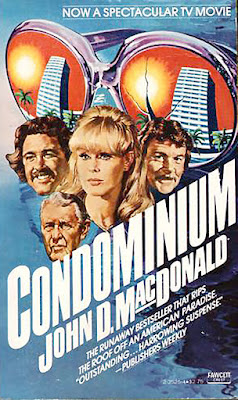 |
| The paperback cover for the 1980 mini-series tie-in is an upgrade from the original design, IMO. |
As MacDonald introduces us to these various supporting characters — including a horny, hot shot real estate agent; an alcoholic widow; a militaristic blowhard obsessed with condo security; a city councilman’s adulterous wife; and an obsessive conspiracy theorist (a pretty labor-intensive pastime pre-internet) — Condominium becomes more than a novel about corrupt businessmen and natural disaster. It’s a novel about the so-called American dream, introducing us to characters who will do anything to attain it, those terrified of losing it, and those disillusioned by the very idea of it.
A passage that particularly resonates, especially now, is a conversation — a soliloquy, really* — that one of these minor characters, retired diplomat Henry Churchbridge, has with his wife Carlotta, when he observes that “Golden Sands and all of Fiddler Key stinks of fear” and why this explains Golden Sands’ resident conspiracy nut C. Noble Winney:
“On the local level they are terrified of predatory tax increases, drunken drivers, purse snatchers, muggers, power failure, water shortages, inflation and the high cost of being sick. Nationally they are afraid of big government, welfare, crime in the streets, corruption, busing, and industrial, political and fiscal conspiracy. Internationally they are afraid of the Arabs, the Blacks, the Cubans, the Communists, the Chinese, the multinational corporations, the oil cartels, pollution of the sea and the air, atomic bombs, pestilence, poisons and additives in food…
“[It] is the vast and wicked complex of interwoven fears, the personal and the specific to the vast misty uncharted, that gives all these people a feeling of helplessness when it comes to comprehending their total environment. … But these people think they have a God-given right to understand. They are educated Americans. They think that if anybody can understand the world and the times, it is an educated American. C. Noble Winney was an auditor, an accountant. Both sides of the sheet must balance. He could not cope with a nonsense world. He had to find a reason why he could not understand events. His only other choice was a permanent condition of confusion and terror. So one day he came across something which hinted at a vast conspiracy. He read further in that area. God knows, there is a very wide choice of fictional conspiracies to accept. The Rothschild anti-Semitic world-control mishmash made some kind of weird sense to C. Noble, and now he documents it. He is still afraid, but he thinks he is doing something constructive to thwart the conspirators by exposing them to people who will join him in his work.”
And this was in the 1970s. If only C. Noble had Facebook and Twitter in his time he might have learned about the Jewish space lasers.
Though I’m partial to MacDonald’s more concise thrillers (A Bullet for Cinderella, Slam the Big Door), I thoroughly enjoyed Condominium, its hardcore business talk notwithstanding. It was easy to see why it was a huge bestseller. The novel was later adapted into a miniseries in 1980 starring Barbara Eden, Dan Haggerty and Steve Forrest. Unfortunately, the miniseries isn’t available on Blu-ray or streaming. I found a copy of it on YouTube, but be warned it that it looks, well, exactly what you’d expect something recorded on VHS over 40 years ago and uploaded at 480p to look like. I haven’t watched it yet, but from reading the Wikipedia synopsis, the adaptation sounds like it has more in common with a Prime-Time soap than the source novel, because TV’s gotta TV.
John D. MacDonald’s Florida may not be as whacked-out as his successors in the crime-in-the-Sunshine State genre, but it’s just as fascinating and well worth seeking out.
*I omitted the wife’s interruptions, which are minimal to the point they strain credulity. As if a married couple has the luxury of speaking in complete sentences, let alone full paragraphs.
ADDENDUM: This book just got a whole lot more relevant!

